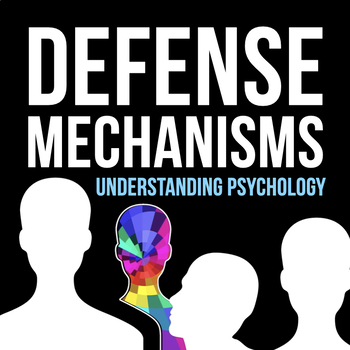Psychology: Defense Mechanisms & Avoiding Stress
- Zip
Also included in
- What's In This Bundle?This bundle contains access to EVERY single paid resource in the Mister Harms store! Save big and go for it! It's EVERYTHING! It's the whole kit and caboodle, the whole enchilada, the whole ball of wax, the whole shebang! Whatever you want to call it, you're going to get it alPrice $248.68Original Price $355.25Save $106.57
Description
Teach your psychology class about defense mechanisms with this content-rich, mini lesson. Sigmund Freud believed that in order to deal with conflict in life, an individual’s ego puts up various defense mechanisms to ward off undesired stress. So what are the various tactics that we as individuals use to avoid conflict and undesired scenarios? This lessons is definitely “on-point” and will give your class the important understandings of the 8 major defense mechanisms. The best part is that there is no prep for you, except downloading and printing! I have also included links to GOOGLE Drive formats so you can edit to fit your needs! Enjoy and if you have time, I’d appreciate your feedback and rating!
What’s Included:
- Step by step guide in how to conduct and lead this mini-lesson.
- A link to an online text for students to read about the various defense mechanisms
- PowerPoint set of notes for whole group instruction that includes a definition and example of the 8 major defense mechanisms.
- Follow up activity for student engagement and reinforcement.
- 16 question worksheet to use for assessing student understanding. This worksheet has 16 different scenarios that students will have to match with the appropriate defense mechanism. (For example: _________ After he is disciplined by his parents, Mikey tends to bully and tease his younger brother and sister.) Answer key is included.
- A completely editable GOOGLE Drive format for both the student assignment and classroom notes. You will be given a link to access these GOOGLE Drive files in the download.
The 8 defense mechanisms studied are: denial, regression, repression, sublimation, reaction formation, rationalization, projection, and displacement.
You may also like:
Psychology: "Wheel of Life Survey" (Stress, Health & Life)
Enchanted City Sleeping Activity: Stages of Sleep
History Biography Summaries: Famous Psychologists Webquest
Psychology: Psychological Disorders Project
Student Goals: Template for setting goals
Classonomics: An Economic Simulation
Want More?
Stay informed: Join the misterharms.com email list for updates and giveaways!
Follow Mister Harms: TpT | Instagram | Twitter | Pinterest | Facebook






